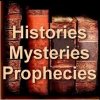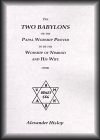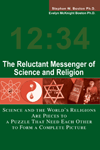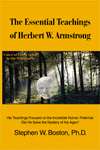
Introduction
Preface Second Ed.
Preface Third Ed.
Note by the Editor
The Two Systems
Trinity in Unity
Mother and Child
The Child in Assyria
The Child in Egypt
The Child in Greece
Death of the Child
Deification of the Child
Mother of the Child
Christmas
Easter
Nativity of John
Feast of thr Assumption
Baptismal Regeneration
Justification by Works
Sacrifice of the Mass
Extreme Unction
Purgatory and Prayers for the Dead.
Idol Processions
Relic Worship.
Clothing and Crowning of Images.
The Rosary
Lamps & Wax-candles
Sign of the Cross
Sovereign Pontiff
Priests, Monks, and Nuns.
Great Red Dragon
Beast From the Sea
Beast from the Earth
Image of the Beast
Number of the Beast
Invisible Head of the Papacy
Woman with Golden Cup
Hebrew Chronology
Shing Moo and Ma Tsoopo of China.
Ala-Mahozim
Meaning of the name Centaurus
Olenos, the Sin-Bearer
Identification of Rhea or Cybele and Venus
Virgin Mother of Paganism
Goddess Mother as a Habitation.
Meaning of the name Astarte.
Oannes and Souro
The Identity of the Scandinavian Odin and Adon of Babylon
Stripping of the Clothes of the Initiated in the Mysteries
Zoroaster, the Head of the Fire-Worshippers
Story of Phaethon
Roman Imperial Standard of the Dragon of Symbol of Fire-worship
The Slaying of the Witness
Attes, the Sinner
Click here for The Reluctant Messenger (Host Site)
APPENDIX - The Story of Phaethon.
NOTE O, p. 230. The Story of Phaethon.
The identity of Phaethon and Nimrod has much to support it besides the prima facie evidence arising from the statement that Phaethon was an Ethiopian or Cushite, and the resemblance of his fate, in being cast down from heaven while driving the chariot of the sun, as "the child of the Sun," to the casting down of Molk Gheber, whose very name, as the god of fire, identifies him with Nimrod. 1. Phaethon is said by Apollodorus (vol. i. p. 354) to have been the son of Tithonus; but if the meaning of the name Tithonus be examined, it will be evident that he was Tithonus himself. Tithonus was the husband of Aurora (DYMOCK, sub voce). In the physical sense, as we have already seen, Aur-ora signifies "The awakener of the light;" to correspond with this Tithonus signifies "The kindler of light," or "setter on fire." * Now "Phaethon, the son of Tithonus," is in Chaldee "Phaethon Bar Tithon." But this also signifies "Phaethon, the son that set on fire." Assuming, then, the identity of Phaethon and Tithonus, this goes far to identify Phaethon with Nimrod; for Homer, as we have seen (Odyssey, lib. v. 1. 121, p. 127), mentions the marriage of Aurora with Orion, the mighty Hunter, whose identity with Nimrod is established. Then the name of the celebrated son that sprang from the union between Aurora and Tithonus, sows that Tithonus, in his original character, must have been indeed the same as "the mighty hunter" of Scripture, for the name of that son was Memnon (MARTIAL, lib. viii., s. 21, p. 550, and OVID, Metam. lib. xiii. 1. 517, vol. ii. p. 467), which signifies "The son of the spotted one," * thereby identifying the father with Nimrod, whose emblem was the spotted leopard's skin. As Ninus or Nimrod, was worshipped as the son of his own wife, and that wife Aurora, the goddess of the dawn, we see how exact is the reference to Phaethon, when Isaiah, speaking of the King of Babylon, who was his representative, says, "How art thou fallen from heaven, O Lucifer, son of the morning" (Isa. xiv. 12). The marriage of Orion with Aurora; in other words, his setting up as "The kindler of light," or becoming the "author of fire-worship," is said by Homer to have been the cause of his death, he having in consequence perished under the wrath of the gods (Odyss. lib. v. 1. 124, p. 127). 2. That Phaethon was currently represented as the son of Aurora, the common story, as related by Ovid, sufficiently proves. While Phaethon claimed to be the son of Phoebus, or the sun, he was reproached with being only the son of Merops--i.e., of the mortal husband of his mother Clymene (OVID, Metam. lib. ii. ll. 179-184, and Note). The story implies that that mother gave herself out to be Aurora, not in the physical sense of that term, but in its mystical sense; as "The woman pregnant with light;" and, consequently, her son was held up as the great "Light-bringer" who was to enlighten the world,--"Lucifer, the son of the morning," who was the pretended enlightener of the souls of men. * The name Lucifer, in Isaiah, is the very word from which Eleleus, one of the names of Bacchus, evidently comes. It comes from "Helel," which signifies "to irradiate" or "to bring light," and is equivalent to the name Tithon. Now we have evidence that Lucifer, the son of Aurora, or the morning, was worshipped in the very same character as Nimrod, when he appeared in his new character as a little child; for there is an inscription extant in these words:-
"Bono DeoPuero Phosphoro." (See WILKINSON, vol. iv. p. 410.)This Phaethon, or Lucifer, who was cast down is further proved to be Janus; for Janus is called "Pater Matutinus" (HORACE, Sat. ii. 6, 20, p. 674; and the meaning of this name will appear in one of its aspects when the meaning of the name of the Dea Matuta is ascertained. Dea Matuta signifies "The kindling or Light-bringing goddess," * and accordingly, by Priscian, she is identified with Aurora: "Matuta, quoe significat Aurorame" (PRISCIAN, ii. p. 591, apud Sir WILLIAM BETHAM'S Etruria, vol. ii. p. 53). Matutinus is evidently just the correlate of Matuta, goddess of the morning; Janus, therefore, as Matutinus, is "Lucifer, son of the morning." But further, Matuta is identified with Ino, after she had plunged into the sea, and had, along with her son Melikerta, been changed into a sea-divinity (Gradus ad Parnassum, sub voce "Ino"). Consequently her son Melikerta, "king of the walled city," is the same as Janus Matutinus, or Lucifer, Phaethon, or Nimrod.
There is still another link by which Melikerta, the sea-divinity, or Janus Matutinus, is identified with the primitive god of the fire-worshippers. The most common name of Ino, or Matuta, after she had passed through the waters, was Leukothoe (OVID, Metam. lib. vi. ll. 541, 542). Now, Leukothoe or Leukothea has a double meaning, as it is derived either form "Lukhoth," which signifies "to light," or "set on fire," * or from Lukoth "to glean." In the Maltese medal given (ante, p. 160), the reader will see both of these senses exemplified. The ear of corn, at the side of the goddess, which is more commonly held in her hand, while really referring in its hidden meaning to her being the Mother of Bar, "the son," to the uninitiated exhibits her as Spicilega, or "The Gleaner,"--"the popular name," says Hyde (De Religione, Vet. Pers., p. 392), "for the female with the ear of wheat represented in the constellation Virgo." In Bryant (vol. iii. p. 245), Cybele is represented with two or three ears of corn in her hand; for, as there were three peculiarly distinguished Bacchuses, there were consequently as many "Bars," and she might therefore be represented with one, two, or three ears in her hand. But to revert to the Maltese medal just referred to, the flames coming out of the head of Lukothea, the "Gleaner," show that, though she has passed through the waters, she is still Lukhothea, "the Burner," or "Light-giver." And the rays around the mitre of the god on the reverse entirely agree with the character of that god as Eleleus, or Phaethon--in other words, as "The Shining Bar." Now, this "Shining Bar," as Melikerta, "king of the walled city," occupies the very place of "Ala-Mahozim," whose representative the Poe is elsewhere (ante, p. 252) proved to be. But he is equally the Sea-divinity, who in that capacity wears the mitre of Dagon (compare woodcuts, pp. 160 and 216, where different forms of the same Maltese divinity are given). The fish head mitre which the Pope wears shows that, in this character also, as the "Beast from the sea," he is the unquestionable representative of Melikerta.
Previous | Next

or The Papal Worship Proved to be the Worship of Nimrod and His Wife
$3.99 Kindle eBook
Buy from Amazon.com
The Essential Teachings of Herbert W. Armstrong
His Teachings Focused on The Incredible Human Potential. Did He Solve the Mystery of the Ages?
New Book about HWA's Teachings. Recommended!

